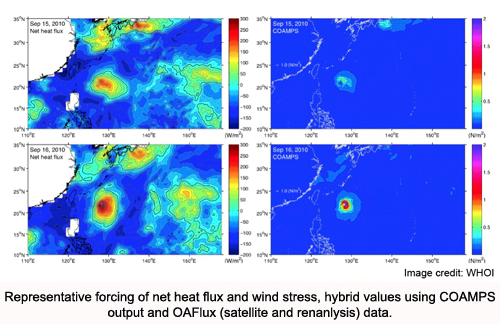Hurricane-Induced Cold Wakes
Currently there is significant interest in the role of cold wakes in the overall ocean climate, including possible ocean heating due to the restratification of these wakes. The warming of the upper ocean associated with restratification may for instance be lost to the atmosphere during winter, with associated implications to the global transport of heat by the oceans.
The main objective of the research is to provide scientists with a clearer understanding of hurricane induced upper ocean mixing, with a focus on the restratification and dispersal of the cold wake, and to provide additional value and insight to the observations already being undertaken by the ITOP program. Our approach is to take two ocean models (our version of CUPOM and HYCOM) that have been adapted for idealized simulations and conduct a series of experiments aimed at understanding the relative roles of the surface forcing, wave-induced mixing and other turbulent processes, and horizontal eddy actions at the mesoscale and submesoscale regimes in affecting the recovery of the ocean from the tropical cyclone. The comparisons of the two models will also provide information on the uncertainty of our results due to varying physical parameterizations of the models, and also provide insight into our further realistic model simulations with the POM model as compared to the work that other researchers are performing with HYCOM.
This will also benefit researchers using coupled atmosphere-ocean models to predict hurricane track and intensity. This improved understanding, particularly of the longer-term restratification, can also be used to address the importance of hurricane-induced mixing for the global ocean thermohaline circulation.

Partners/ Collaborators
This is a joint project with Institution Number One, College Number Two, Organization Number Three, and Corporation Number Four.
Related Links and File
- Impact of Typhoons on the Ocean in the Pacific (ITOP)
- Colorado University Princeton Ocean Model (CUPOM)
- The HYbrid Coordinate Ocean Model (HYCOM)
- Coupled Ocean/Atmosphere Mesoscale Prediction System (COAMPS)
- Objectively Analyzed air-sea Fluxes for the Global Oceans (OAFlux)
- Princeton Ocean Model (POM)

